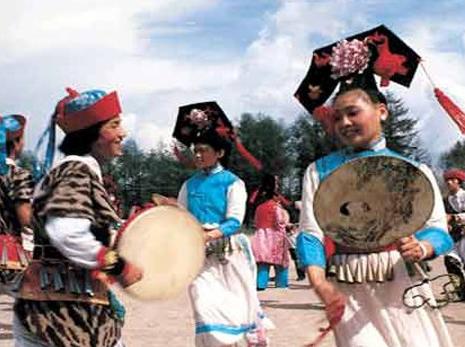
Changbai Mountain in the southeast of Jilin Province is the Manchu.cradle of the It was on this boundless, beautiful and mysterious fertile land that the Manchu forefathers lived and multiplied since time immemorial. The Manchu Shuobu is a form of ancient art of singing and recital with considerable length, which has been passed down orally by the Manchu people and their ancestors. It is called "Ulabun" in Manchu language, meaning "Biography" in mandarin Chinese. Different from common folklores, its form and connotation are usually preached by superiors in the tribe after gargling and burning incense. It is often accompanied by tambourine and pricked board and inserted with narration and singing, with the aim of narrating "Origin", showing respect for ancestors, and praising heroes. The listeners must be courtly, orderly and devout. The Manchu Shuobu takes root in preaching customs of Manchu people and their ancestors. It is derived from the Manchu tribe's adoration of heroes in previous generations.
Folk Shuobu of the Manchu stems from "Jianggu" - a form of folk narration with a longer history. Called "Uabun" in Manchu language, Juanggu means legend or story, namely, telling stories about the Manchu (especially its clan) in history. Before entering and governing the Central Plains, the Manchu had hardly got into the habit of recording its own history in writing. The only mode of history recording among Manchu people is oral narration of history and education of the offspring by the chief or Shaman of the tribe. Generation of folk Shuobu can be also attributed to the influence by traditional storytelling of the Han Chinese. The Manchu ever aspired after the throne in China for two times in the history, which exerted considerable influence on the culture of the Central Plains. Meanwhile, the Manchu did absorbed excellent culture of the Central Plains to a great extent during the long-term intercourse with the Han Chinese. Folk storytelling is a typical example in this regard.
Preserved transcripts of Shuobu mainly include such contents as "Wocheku Ulabun", "Baoyi Ulabun" and "Batulu Ulabun". "Wocheku Ulabun", which is also known as "Stories on Shrine", is collected with myths of the Shamanism and stories of Shamans in previous generations as having been passed down by Shamans with different surnames. "Baoyi Ulabun", having the meaning of family legend and history, has been found in quite a lot of families with surnames of the Manchu over these ten years. "Batulu Ulabun" means "Legend of Heroes". Shuobu contains abundant contents, ranging from rectification of historical errors to the supplementation of historical materials, some of which are unknown to people in later generations. Collection and exploration of Shuobu are of crucial value for the research on the history of Northeast Manchu, ethnic relations and foreign domain in Northeast China. For instance, Legend of Black-water Heroes and Legend of King Han on the Snow Mountain are recorded in details with the life of indigenes living on the boundless cold region to the north of Heilongjiang River and Karafuto as well as historical stories of "Sixty four villages to the east of the Heilongjiang River".





